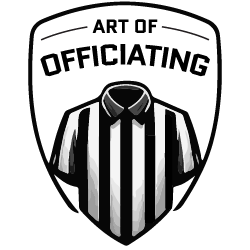When communicating with coaches, we need to be clear, concise, and correct. Get into the habit of repeating Rules Book verbiage as much as possible. Additionally, we can use descriptive words that, while not in the Rules Book, provide needed clarity.
Here are some examples (I’ll also highlight other useful amplifying words in each paragraph):
Restriction (Blocking) – “Demonstrated Restriction” is one of the three components we look for when deciding if a block is legal or illegal. We won’t immediately flag a blocker for grabbing a jersey or having his arms outside the defender’s torso. “Coach, I did see the jersey grab, but in my judgment, I didn’t see any restriction. Your player was torso to torso and made no effort to move around the blocker.”
Pass Interference Descriptive Words – Rule 7-5-10 says, “It is forward-pass interference if any player of A or B who is beyond the neutral zone interferes with an eligible opponent’s opportunity to move forward, catch, or bat the pass. The Rules Book does not clearly state what constitutes interfering with the opponent. These pass interference “categories” are not expressly in the Rules Book, but they provide clarity when describing why the official threw a flag or elected to pass on a foul: Contact not playing the ball, Playing through the receiver, Cut off, Arm bar, Hook and turn, and Grab and restrict.
Separation – This word is helpful when describing contact between a defender and receiver. We’ll often see some level of “chicken fighting” between a defensive back and receiver. Unless we see restriction (another opportunity to use that word) or separation, we probably won’t have a foul. “Coach, I didn’t see the receiver extend his arm to create separation before catching the pass.”
Renewed effort – This word is useful if a coach wants a flag for a late hit out of bounds. “Coach, the defender initiated contact in the field of play and completed the tackle out of bounds. I didn’t see any renewed effort by the tackler after your runner went out of bounds.”
Unnecessary – Contact can appear legal (not above the shoulders, below the waist, or in the back), but the timing of the contact will warrant a flag. Review Rule 2-32-16 (defenseless player) and Rule 9-4-3g. A coach may complain when we flag his player for illegal personal contact when he slams into a player who is passively standing upright yards away from a moving pile. “Coach, we don’t blow the whistle unless we can see the ball. The pile was still moving. Your player slammed into an opponent who was obviously out of the play. That was unnecessary contact.”
Delivered a blow – Head-to-head contact is inevitable. That’s why players wear helmets. Players may inadvertently crack helmets when tackling a runner or chasing down a loose ball. If we elect to throw a flag for illegal helmet contact, we must describe why the contact was a foul. “Coach, your player lowered his head and initiated contact/delivered a blow with the crown of his helmet.”
For more information on how to effectively communicate with coaches, go to this link:
https://artofofficiating.com/ready-for-play/responding-to-a-coach/
Quiz
Read the quiz stem and then choose the best answer.
3/12 from the A-32. Quarterback A12 retreats under a heavy rush. A12 fumbles at the A-25 as B77 grabs and twists his facemask. The ball rolls forward and out of bounds at the A-30. The penalty for B77’s personal foul will be enforced from the ________.
- A-25 (spot of the fumble)
- A-30 (out of bounds spot)
- A-32 (previous spot)
Review Rule 10-4-2b
